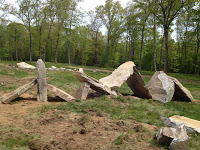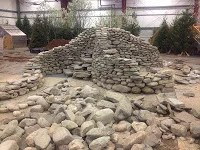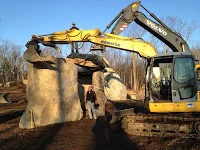Much of the art and architecture of ancient cultures was funerary. The Egyptian pyramids and the Taj Mahal, for example, are tombs. Artistic creations such as The Terracotta Army of the Qin Emperor and large pieces of pottery that marked Early Greek burials were artistic creations separate from the venerated human remains. Works I’ve done recently fall into both categories.
Read MoreOver time, I’ve expanded the walling work that’s been the backbone on my career to include dry stone sculpture and environmental art. The designs typically take dry stone techniques and traditions into new territory. A concept will be explored through the lens of what’s known to have worked in the past. The core of a design is always some borrowed understanding. It might be my own knowledge gained from a previous project, or, it may be the experience of others made intelligible through observation and study. Design is applied comprehension. The creation of an art piece begins with fabrication and ends with installation.
Read MoreThe use of an old millstone as a lawn ornament is a notion that never grows old. They’re seen laid flat with flowers growing from the central axle hole, or set on edge with the lower portion buried in the ground. The mill building, where the stone once turned, may be long gone but the stone endures and remains a symbol of industry and ingenuity from times past.
Read MoreWhile I was in Newfoundland, ET, John, Andy, and the rest of the crew were making a full size mockup of the three-stone piece that will soon be installed on Hogpen Hill. The “inflatable stones,” as ET refers to them, are made from steel frames sheathed in plastic shrink-wrap. Yesterday the mockup took flight, with the aid of the excavator bucket, around the field seeking a site for the permanent installation.
Read MoreThe difference between stone and rock is that rock only becomes stone when it gains employment. Whether fixed or loose, rock belongs to the earth. When humans pick it up and turn it to a use it becomes stone. There are many ways to make the transformation. Here are two examples.
Read MoreThe past two days have been a swirl of activity as months of planning finally came together, including the 25-ton dry stone installation created by Jared Flynn, Jamie Masefield, T.J. Mora, Brian Post and me. Behind the scenes, Charley McMartin coordinated the collection and delivery of the stone and will take care of the break-down Sunday night.
Read MoreModeling clay is one of my favorite sketch materials. It reveals more about the true reality of an idea than a drawing does. Manipulating materials on a small scale runs up against some of the same issues that will be present when constructing a full scale rendition in stone.
Read MoreGetting to work with skilled professionals under the direction of an artist who takes great joy in the making of things is pure delight for me. This week I was again on Hogpen Hill with Edward Tufte creating monumental lithic assemblages. From time to time, over the past year, I’ve gone to western Connecticut to collaborate with my stone-loving colleague. With each session, we’ve explored new ways to combine large stones with the landscape. The stones are dug up from just under the surface of the ground near the assembly points. Each “foundling” is a gift of unique shape and texture bringing with it another possibility for construction.
Read MoreEdward Tufte and the crew at Hogpen Hill Farms stayed busy on the land while I was away in Newfoundland and Oregon. An exciting collection of stones greeted me on arrival this past Monday. Edward’s sketches illustrated the direction he wished to move the work. Frank, Rob, Tom and I got right into it, constructing an 14’ high A-frame shaped piece. By Wednesday we were back on the ridgeline connecting the network of dolmens built earlier in the summer with high cross-members. A three-stone colossus now frames a dramatic view of the extended works.
Read MoreThe 34-stone construction is made from stream-worn “pillow” basalt boulders gathered from a gravel bank along the Santiam River in Mill City, Oregon and 70 year-old hand split, cast-offs collected from an abandoned granite quarry in Haines, Oregon. The stones are held in place by gravity and friction aided by stainless steel pins for lateral strength. The total weight of the piece is 15 tons, the largest stone weighing 4 tons. The piece covers a 10’x30’ area and is 6’ tall at it’s highest point.
Read MoreThe 34-stone construction is made from stream-worn “pillow” basalt boulders gathered from a gravel bank along the Santiam River in Mill City, Oregon and 70 year-old hand split, cast-offs collected from an abandoned granite quarry in Haines, Oregon. The stones are held in place by gravity and friction aided by stainless steel pins for lateral strength. The total weight of the piece is 15 tons, the largest stone weighing 4 tons. The piece covers a 10’x30’ area and is 6’ tall at it’s highest point.
Read MoreI’m delighted by this new-found perspective which has been amplified this past week by my being in Bend, Oregon. The city of 80,000 has doubled its population in the past 20 years. The increase is due in large measure by the influx of people like Jeff Fairfield and his wife Samantha. Both Maine natives, they moved to the Bend area 6 years ago to begin their careers building dry stone walls and teaching horseback riding. Jeff’s joining me on the Tarriance at COCC this week got the project off to a great start. After taking delivery on 15 tons of stone we made full-scale, foam board, mock-ups of the individual pieces. With them I could quickly try out different granite slab and basalt boulder arrangements.
Read MoreThe last day on our transcontinental journey begins in Twin Falls, Idaho. By this afternoon we should be at our Oregon destination for the installation of a sculpture at the Central Oregon Community College. The O.H. and I have tag-team driven from Eastern Newfoundland across three provinces and twelve states in the past week and a half with just a 2-day stop at home in Vermont to unpack and repack the car. The weather has been cooperative, only occasional rain-storms and wind gusts to impede our westerly progress.
Read MoreThe last five pages of my notebook are covered in boulder sketches. Each one records the shape and dimensions of a large stone in Edward Tufte’s growing stock yard of material pried loose from ledges on his Hogpen Hill Farm. The pencil sketches are the first step in a method of discovery I’ve employed for designing megalithic constructions since 1981 when I won a NEA grant for studying amphitheaters. From the drawings I fashion ¼” -1’ clay models of the stones. With the clay pieces I can try out a variety of construction configurations before confronting the actual boulders. The small-scale assemblages allow for freedom to experiment with different design concepts.
Read MoreMy time in the eye of the stone has passed. Yesterday saw the final vertical pieces set in the Horse Eye sculpture. Phase One is complete except for two elements being carved by Chris Curtis of West Branch Gallery in Stowe, Vermont. They will be lowered into place at a later date, replacing the styrofoam mock-ups. The carved pieces will represent the “third eyelid.” The third eyelid of a horse is the lightning-fast flap that zips across from the inner corner to seal the eye shut against threat even before the lids can close. It's also the source of lubricating tears.
Read MoreAnother dry stone landform has begun to take shape at Hogpen Hill Farms. Three dozen “tables” have been assembled along one of the long ribs that constitute the high ground in the woodland park. The directive by Edward Tufte for this piece is to create the illusion of stones floating along the ridge top when viewed from the low ground along each side of the rib, and to establish a strong linear pattern from the bird’s eye view.
Read MoreUnlike the majority of the world’s art pieces, displayed in controlled settings of four walls and artificial lighting, environmental art works are not fixed in time or static in space. They develop a life of their own beyond their moment of creation. To view a piece of environmental art over a span of time is to connect what was known with what is new, to accept what’s been lost and celebrate what’s been found.
Read More“Diamond Mines” is an abstract, site-specific sculpture built of loose, natural stone. The work is situated on westward-sloping ground in a grove of mature beech trees. Wooded hills rise to the north and south. Park paths wind along the west and north sides of the sculpture. To the west, Tranekær lake and castle can be viewed. ‘Diamond’ is the perimeter, outline shape of the sculpture. The shapes of the nineteen interior facets are also diamond. There are a total of eighty-five obtuse and acute angles in the sculpture. The stones are set on their near-vertical axis in the construction, pointing up and down in the wall faces. In “Diamond Mines” there are diamonds within diamonds within a diamond.
Read More
















